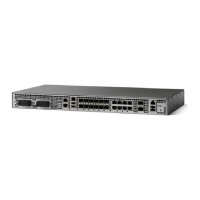

Do you have a question about the Cisco ASR 900 Series and is the answer not in the manual?
| Product Family | ASR 900 Series |
|---|---|
| Category | Network Router |
| Connectivity Technology | Wired |
| Switching Capacity | Varies by model |
| Memory | Varies by model |
| Operating System | Cisco IOS XE |
| Dimensions | Varies by model |
| Weight | Varies by model |
| Form Factor | Modular |
| Supported Interfaces | Ethernet, Gigabit Ethernet, 10 Gigabit Ethernet, T1/E1, T3/E3, OC-3/STM-1, OC-12/STM-4, OC-48/STM-16 |
| Ports | Varies by model |
| Data Link Protocol | Ethernet, Fast Ethernet, Gigabit Ethernet |
| Network / Transport Protocol | TCP/IP, UDP |
| Routing Protocol | BGP, OSPF, IS-IS, RIP, EIGRP, MPLS |
| Remote Management Protocol | SNMP, CLI, SSH |
| Features | MPLS, QoS, IPv6, NetFlow, ACLs, VRF |
| Power Supply | AC or DC |
| Operating Temperature | 0 to 40°C |
| Storage Temperature | -40 to 70°C (-40 to 158°F) |
| Humidity | 5% to 95% (non-condensing) |
Locates information about features, caveats, and release notes.
Provides an overview of MPLS functionality and its role in networks.
Explains basic configuration for MPLS switching and forwarding.
Lists related documents for Cisco IOS commands and MPLS commands.
Details software release information for MPLS features.
Defines key terms and acronyms used in the document.
Lists limitations and unsupported features for MPLS-TP on specific routers.
Explains how MPLS Transport Profile works, including LSPs and pseudowires.
Provides steps for configuring MPLS Transport Profile, including label ranges.
Offers practical examples of MPLS Transport Profile configuration scenarios.
Lists requirements for enabling MPLS Multilink PPP support.
Details limitations on multilink bundles and members per bundle.
Describes Layer 3 VPN features and QoS features supported for Multilink PPP.
Guides through configuring MPLS Multilink PPP support, including bundle creation.
Provides sample configurations for MPLS Multilink PPP in various network scenarios.
Lists prerequisites before using MPLS LSP Ping, Traceroute, and AToM VCCV features.
Details limitations on using MPLS LSP Ping and Traceroute for specific applications like AToM and VPNs.
Explains MPLS LSP Ping operation, echo request/reply paths, and packet handling.
Describes command options and arguments for MPLS LSP Ping and Traceroute.
Explains how to select Forwarding Equivalence Classes (FECs) for LSP validation.
Controls how the responding device replies to MPLS echo requests.
Describes how IP and MPLS packets with router alert options are handled.
Details additional command options for MPLS LSP Ping and Traceroute.
Troubleshoots issues when MPLS echo replies return a 'Q' code, indicating packet transmission failure.
Explains how MPLS uses source/destination addresses for load balancing.
Locates information about features, caveats, and release notes for NSR LDP Support.
Lists requirements for NSR LDP Support to function correctly.
Details the roles of standby RP and LDP, and NSR operation states.
Provides steps to enable and configure NSR LDP Support.
Shows sample configurations for NSR LDP Support, including verification steps.
Lists related documents and technical assistance resources for NSR LDP Support.
Provides release-specific information for NSR LDP Support features.
Provides an overview of VPLS implementation over MPLS-TP.
Guides through the configuration steps for VPLS over MPLS-TP.
Details commands for verifying VPLS configuration and debugging.
Offers practical examples for configuring VPLS over MPLS-TP.
Lists software release information for VPLS over MPLS-TP features.
Locates information about features, caveats, and release notes for Circuit Emulation over UDP.
Lists limitations and unsupported features for Circuit Emulation Service over UDP.
Explains CES overview, pseudowire emulation, and CESoPSN mode.
Guides through configuring Circuit Emulation Service over UDP.
Details the Structure-Agnostic TDM over Packet (SAToP) encapsulation method.
Guides through configuring Structure-Agnostic TDM over Packet (SAToP).
Demonstrates how to verify the SAToP configuration.
Explains association signaling methods for bidirectional LSPs in Flex LSP.
Overviews associated bidirectional LSPs, covering non co-routed and co-routed types.
Lists limitations and recommendations for Flex LSP deployments.
Guides through configuring co-routed bidirectional Flex LSPs, including setup steps.
Details configuration steps for non co-routed inter-area Flex LSP tunnels.
Covers features supported in Flex LSP Phase 2, like SRLG protection and ECMP.
Explains how to configure SRLG and exclude options for Flex LSP explicit paths.
Guides on configuring non-revertive path protection for Flex LSP.
Guides on configuring the sticky option for Flex LSP path protection.
Explains configuring hop count and accumulated path cost limits for Flex LSPs.
Details configuring ECMP tie-breakers like min-fill, max-fill, and random for Flex LSPs.
Explains how to configure and verify the restore path option for Flex LSP tunnels.